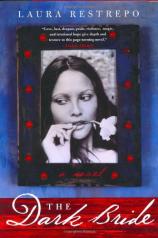Reading Group Guide
Discussion Questions
The Dark Bride: A Novel

1. The narrator of The Dark Bride is a journalist conducting research, and much of the story unfolds in a series of memories and flashbacks as she interviews the various characters. What do you think of this technique? In what ways did it enhance the telling of Sayonara's story? How would the novel have differed if it had been told as a straight narrative? What do you think are the narrator's motivations?
2. At one point in the story, when conversing with Sacramento, the narrator realizes that she has "entered into a world of performances where each person approaches or retreats from his character." What does the narrator mean by this statement? Cite some examples of how this plays out throughout the story.
3. About Todos los Santos and Sayonara, the narrator says, "They needed each other, like a fish needs the cloud that will later become water, for obvious and complementary reasons." How would you characterize their relationship?
4. The Dark Bride is a work of fiction, but many aspects of the story are based on research the author conducted for a nonfiction article on prostitution in Colombia. Does having this knowledge change how you view the story and the characters? Did any of the depictions of La Catunga and its inhabitants surprise you?
5. Todos Los Santos states, "Seen from above, all human life seems like a tangle of whims, becauses, and for-no-reasons, and only by intense scrutiny and thorough searching for its ends, over the long term, do you begin to find a pattern. Even those who are most caught up in the foolishness are clear about their motives for doing what they do, and there is no chance occurrence that isn't, in and of itself, a known result." How would you describe the different motivations of the characters in the book? In what ways are they in conflict with one another?
6. Sayonara is fascinated by the postcards that Sacramento sends to her. Why is this? One postcard in particular -- depicting a snow-covered village -- leads to Sayonara's fascination with snow and her many hours of conversation about it with Frank Brasco. What is it about the idea of snow that fascinates Sayonara? What does it represent to her?
7. Todos los Santos makes the following statement: "Religion in excess makes good nuns and terrible putas." Does religion play a role in the lives of the putas of La Catunga? How so?
8. Why is Sayonara so secretive about her past, not even revealing her name when she first arrives in Tora? How would you relate the circumstances of her childhood-including the deaths of her mother and brother-to the life she grows up to lead? Why does Sayonara eventually seek out her father?
9. The rice strike at the Tropical Oil Company is a momentous event in the novel. How does it affect both the petroleros and the putas? Why does Todos los Santos take Sayonara and her sisters to peer through the fence surrounding the quarters where the Tropical Oil Company houses its North American personnel? How does this incident relate to larger themes in the story?
10. Compare Sayonara's relationships with Payanés and Sacramento. Sacramento tells the narrator that he could not forgive Payanés' betrayal, and that he also blamed Sayonara for having left him without a best friend. He then says, "Today I regret hurting her with the accusations, but at the time I let myself get carried away with the question that has no answer, whose fault was it, hers, his, or perhaps mine, or was it life's?" Was the situation anyone's fault? What could have each of the three characters done differently?
11. How do you interpret the novel's ending?
12. Compare The Dark Bride to other novels of magical realism that you have read, including those by Gabriel García Márquez and Isabel Allende.
The Dark Bride: A Novel
- Publication Date: August 20, 2002
- Hardcover: 368 pages
- Publisher: Ecco
- ISBN-10: 006008894X
- ISBN-13: 9780060088941






